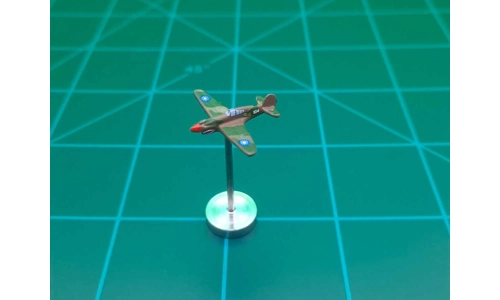Product Added to your Cart
P-40 Flying Tigers
Product Details
- P-40 Flying Tigers
- P40-AA-P
-
- Units in Stock: 4
P-40 Flying Tigers Summary
The Curtiss P-40 Warhawk first flew in 1938, and was a modification of the previous Curtiss P-36 Hawk, which reduced development time and enabled a rapid entry into production and operational service. The Warhawk was used by most Allied powers during World War II, and remained in frontline service until the end of the war. It was the third most-produced American fighter of World War II, after the P-51 and P-47.; When production ceased in November 1944, a total of 13,738 had been built.
P-40s first saw combat with the British Commonwealth squadrons of the Desert Air Force in the Middle East and North African campaigns, during June 1941.
The P-40's lack of a two-speed supercharger made it inferior to Luftwaffe fighters such as the Messerschmitt Bf 109 or the Focke-Wulf Fw 190 in high-altitude combat and it was rarely used in operations in Northwest Europe. However, between 1941 and 1944, the P-40 played a critical role with Allied air forces in three major theaters: North Africa, the Southwest Pacific, and China. It also had a significant role in the Middle East, Southeast Asia, Eastern Europe, Alaska and Italy. The P-40's performance at high altitudes was not as important in those theaters, where it served as an air superiority fighter, bomber escort and fighter-bomber.
While it was generally considered a medicre design, 200 Allied pilots became aces flying the P-40. Perhaps the biggest advantage of the design was its very low cost. This allowed large numbers to be produced, and this kept it in production as a ground-attack aircraft long after it was obsolescent as a fighter.
The Flying Tigers, known officially as the 1st American Volunteer Group (AVG) based in China, were recruited from U.S. Navy, Marines and Army aviators yet were a part of the Chinese Air Force.
Compared to opposing Japanese fighters, the P-40B's strengths were that it was sturdy, well armed, faster in a dive and possessed an excellent rate of roll. While the P-40s could not match the maneuverability of the Japanese Army air arm's Nakajima Ki-27s and Ki-43s, nor the much more famous Zero naval fighter in slow, turning dogfights, at higher speeds the P-40s were more than a match. AVG leader Claire Chennault trained his pilots to use the P-40's particular performance advantages.[54] The P-40 had a higher dive speed than any Japanese fighter aircraft of the early war years, for example, and could exploit so-called "boom-and-zoom" tactics. The AVG was highly successful, and its feats were widely publicized by an active cadre of international journalists to boost sagging public morale at home. According to its official records, in just 6+1⁄2 months, the Flying Tigers destroyed 297 enemy aircraft for the loss of just four of its own in air-to-air combat.
All pieces come magnetized.
"The P-40 Flying Tigers have great detail and brings the gaming experience to life! Highly recommend!"
Genaro Guerrero - Friday, July 28, 2023
"These were the touch that China needed on our board. Thrilled to have them!"
Mike - Sunday, January 5, 2025
"Very happy with this piece great detail"
Danny Lester - Friday, April 26, 2024
